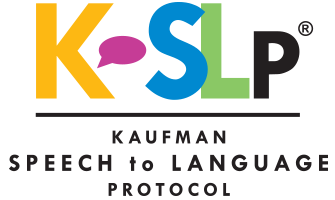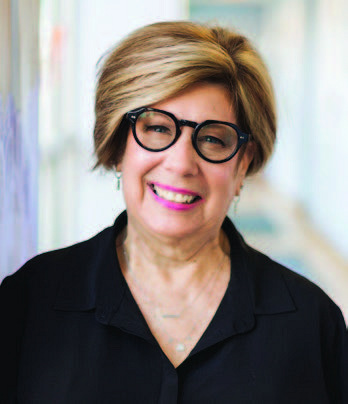Kaufman Apraxia | K-SLP Research
Treating Apraxia?
Use this proven systematic word simplification approach to shape and expand verbal communication. The K-SLP materials were designed by Nancy R. Kaufman, M.A. CCC-SLP, to help children move from sounds to words to sentences while controlling for speech motor difficulty throughout the treatment process.
Latest Published Research
This recent research paper finds the Kaufman Speech to Language Protocol (K-SLP) improves expressive language and carryover in everyday activities in addition to improving speech intelligibility.
-
New! Effectiveness of the Kaufman Speech to Language Protocol for Children With Childhood Apraxia of Speech and Comorbidities When Delivered in a Dyadic and Group Format
Aravind K. Namasivayam, Karina Cheung, Bavika Atputhajeyam, Julia Petrosov, Miriam Branham, Vikas Grover and Pascal van Lieshout. (1 October 2024) American Journal of Speech-Language Pathology.
Highlights of the Namasivayam research paper:
- Simplification and successive word approximations gradually builds complex syllable shapes and facilitates incremental progress in speech-motor control simultaneously enabling the acquisition of functional vocabulary.
- Limits the destabilizing interactions between speech-motor and language systems.
- Supports moving forward on expressive language while controlling for speech-motor difficulty.
- The K-SLP approach may be particularly relevant for younger children with CAS, typically under 4 years old, who exhibit limited/minimal spoken language skills alongside cognitive or behavioral challenges.
- The K-SLP methods are consistent with contemporary theories/models that highlight the bidirectional interaction between speech-motor and language development.
Evidence-Based Practice
A great deal of evidence and peer-reviewed research on the Kaufman Speech to Language Protocol has been completed! Links to online articles have been included where possible:
-
Data-Driven Care Pathway For Children Over 36 Months Of Age With Motor Speech Disorders
Namasivayam A.K., Shin. H., Nisenbaum, R., Pukonen. M., & van Lieshout, P.H.H.M. (2022, in prep). Predictors of functional communication outcomes in children with motor speech disorders.
Namasivayam, A.K., Pukonen, M., & van Lieshout, P.H.H.M. (August 2022). Data-driven care pathway for children over 36 months of age with motor speech disorders. Poster presented at the 8th International Conference on Speech Motor Control, Groningen, The Netherlands.
-
Apraxia Of Speech In Children And Adolescents: Application Of Neuroscience To Differential Diagnosis & Intervention
Burns, M.S. (April 01, 2011). Perspectives on Neurophysiology and Neurogenic Speech and Language Disorders, 21, 1, 15
-
Bridging The Gap Between Speech And Language: Using Multimodal Treatment In A Child With Apraxia
Tierney, C., Pitterle, K., Kurtz, M., Nakhla, M. & Todorow, C. (September 01, 2016). Pediatrics, 138, 3
-
Effect Of Tutor-Modeled Successive Approximations Versus Tutor-Modeled Adult Forms To Improve Topography Of Tacts
Eldridge, A., Kasper, T. & Goodwin, J. (2006). Presented at the International Convention of the Association for Behavior Analysis, Atlanta, GA
-
A Survey Of The Clinical Management Of Childhood Apraxia Of Speech In The United States and Canada
Gomez, M., McCabe, P., Purcell, A., Faculty of Medicine and Health, The University of Sydney, Australia (March-April, 2022). Journal of Communication Disorders, Volume 96, 106193
-
Efficacy Of The Kaufman Approach In Increasing Speech Output With A Low-Verbal Child With Autism Spectrum Disorder
Holbrook, S., King, L. & Pelayo, H. (2013). Presented at the Annual Loma Linda University, School of Allied Health Professions, Department of Communication Sciences and Disorders Graduate Research Symposium, Loma Linda, CA
-
Increasing The Vocal Responses Of Children With Autism And Developmental Disabilities Using Manual Sign Mand Training And Prompt Delay
Carbone, V., Sweeney-Kerwin, E., Attanasio, V., & Kasper, T. (2010). Journal of Applied Behavior Analysis, 43(4), 705-709
-
Intensive CAS Summer Program: Boost Or Bust?
Nancarrow, D., Kaufman, N., & Ficker, L. (2013). Poster presented at the American Speech-Language-Hearing Convention, Chicago, IL
-
Shaping Successive Approximations For Speech Intelligibility: Effect Upon Language
Nancarrow, D., Kaufman, N. & Burns, M. (2009). Presented at the American Speech-Language-Hearing Association Annual Convention, New Orleans, LA
-
Treating Childhood Apraxia Of Speech With The Kaufman Speech To Language Protocol: A Phase 1 Pilot Study
Gomez, M., McCabe, P., Jakielski, K. & Purcell, A. (January 01, 2018). Language, Speech, And Hearing Services in Schools, 2018, 1-13
-
Improving Vocal-Verbal Behavior Via Tutor-Modeled Successive Approximations
Kasper, T. & Godwin, J. (2003). Presented at the International Convention Association for Behavior Analysis, San Francisco, CA
-
Hundreds of hours of video recordings demonstrating the K-SLP teachings, progress, and retention. Plus, nearly 40 years of clinical experience!
Myths About The K-SLP
The K-SLP is just a drill program using picture cards.
The K-SLP is not just a drill oriented method. It is not just about the picture cards in Kits 1 and 2. Play is incorporated into every session. Picture cards are initially implemented, as it is too difficult to contrive the specific targets for the child to be able to practice the specific vowels, consonants, and syllable shapes with enough repetition necessary for success.
If the SLP is only using the Kit pictures within a session, they are not implementing the K-SLP the way it was intended! Sessions can and eventually should be conducted without any pictures at all. For very young children, pictures are not introduced until the task of imitation is understood, and there are always targeted goals through play.
Practicing new skills through play and the natural environment is essential to the K-SLP methods. The K-SLP is implemented with high levels of motivating toys and activities in a warm, encouraging manner. Many responses are necessary for success. Therefore, you will see a great deal of repetition in a K-SLP session.
The children are willing, cooperative and successful learners if the K-SLP is done the way in which it was intended.
One should never teach those with CAS approximations of words. They would then learn erroneous motor plans. They should always be taught full, adult forms of words. Children with CAS should also not be taught an approximation of a difficult consonant or vowel with a compensatory placement.
The K-SLP effectively involves teaching word approximations toward target words, phrases and sentences, and not simply just accepting the child’s approximation. Word approximations are continuously shaped toward the full target words to perfection.
Once the child learns a closer approximation of a target word, the old approximation is extinguished and only the closer approximation is reinforced. Full correct words and phrases are always modeled for the child. If the child is not stimulable to produce a vowel or consonant accurately, they would be taught a compensatory placement, while continuing to gain stimulability for articulatory accuracy.
There is a great deal of research supporting teaching a new behavior (in this instance, the behavior of producing and combining vowels and consonants to form words, and combining words to formulate language) through shaping successive approximations. (See the list of evidence based practice).
Every child Nancy Kaufman or any SLP at the Kaufman Children’s Center has ever taught to develop effective vocal communication was taught via successive word approximations and compensatory articulatory placements. The K-SLP methods have been implemented successfully since 1979.
There is no evidence to back up the K-SLP methods.
Due to the nature of the K-SLP, it is difficult to systematize the process so each clinician is using the exact same intervention strategies. The protocol depends upon a wide range of variables including:
- The individual clinician
- How cues are chosen
- How motivation and reinforcement is implemented
- How to simplify the motor plans of words temporarily based upon the child’s repertoire
However, a great deal of evidence and peer-reviewed research has been completed. You can find a list of resources above.
TalkTools and Oral Placement Therapy (OPT) are simply oral-motor therapy exercises and should not be implemented for those with CAS.
There are many controversies surrounding “oral-motor therapy.” The research has taught us that oral-motor exercises do not help children to be more successful vocal communicators if they are exhibiting only characteristics of CAS. We do not implement oral-motor exercises at all for this population of children.
Specific tools established and offered through TalkTools have been instrumental for those who have very few vowels or consonants within their repertoire and who struggle with the underlying oral placement to sustain the accuracy of a vowel or consonant. When appropriate, a tool will be implemented inside the oral cavity to assist the child as a cue (much like how PROMPT cues are used outside of the oral cavity) for initial success, then the tool is faded out as the child is able to produce the underlying movement to sustain the new vowel or consonant independently.
TalkTools are also implemented here at the KCC to assist with the quality of feeding for those children who struggle with sucking, chewing and swallowing, and who also struggle to speak. Horns and/or straws are only introduced to gain the necessary skills for improved feeding or as a tool to gain a vowel or consonant as above. Sometimes, horns are introduced to help the child to practice sustaining respiratory support that would be needed to support sentence length or as a tool to be paired directly with a consonant that requires sustaining and grading air flow such as for /s, f, sh/.
The K-SLP materials must be used when implementing the methods.
K-SLP materials are not essential for successful K-SLP methods. They were produced by Nancy as she needed/wanted them for stimuli and assumed that other SLPs might also find them to be useful. If SLPs understand the K-SLP methods, all that is needed are pictures, objects, toys, and other highly preferred items or activities for each child. Each SLP will also require knowledge about how to simplify the motor plans of words by implementing natural phonological processes and understanding shaping methods.
Meet The Author
Nancy R. Kaufman, MA, CCC-SLP, has dedicated herself to establishing the Kaufman Speech to Language Protocol (K-SLP) since 1979, a treatment approach to help children become effective vocal communicators. The K-SLP has evolved over the years to include the most current research in childhood apraxia of speech (CAS), motor learning, and applied behavior analysis (ABA), and its methods and materials are used by speech-language pathologists worldwide. In addition, many ABA specialists have adopted the K-SLP for children with autism spectrum disorders.
Nancy lectures locally, nationally, and internationally on the subject of CAS and other speech sound disorders in children. Families from around the country and the world travel to the Kaufman Children's Center for Speech, Language, Sensory-Motor, and Autism Treatment, Inc (KCC) in West Bloomfield, Michigan to participate in intensive, specialized therapy programs. The KCC continues to grow, offering renowned speech, language, occupational therapy, sensory integration, and applied behavior analysis (ABA).
Nancy served as a member of the Professional Advisory Council for Apraxia Kids for 10 years. Currently, she serves on the board of visitors of Wayne State University's Merrill Palmer Skillman Institute for Child and Family Development. She is the speech-language pathologist consultant for the Parish School and Carruth Center in Houston, Texas, and for the Suburban Speech Center in Short Hills, New Jersey, providing a new consulting opportunity for other small groups of speech and language pathologists known as Therapy Notes from Nancy.
Nancy has been honored by both of her alma maters: she received the Distinguished Alumni Award from Wayne State University in 2015 and the Outstanding Alumni Award from Michigan State University in 2010. She was awarded the Michigan Speech-Language-Hearing Association (MSHA) Distinguished Service Award in 2011 and the West Bloomfield Township Chamber of Commerce Community Excellence Business Person of the Year Award in 2015. She was also recognized by the Lawrence Technological University Leaders & Innovators program. The KCC has received MSHA's Clinical Service Award and Corp! Magazine's Best of Michigan Business Award. Nancy has three grown children and resides with her husband in West Bloomfield, Michigan.

